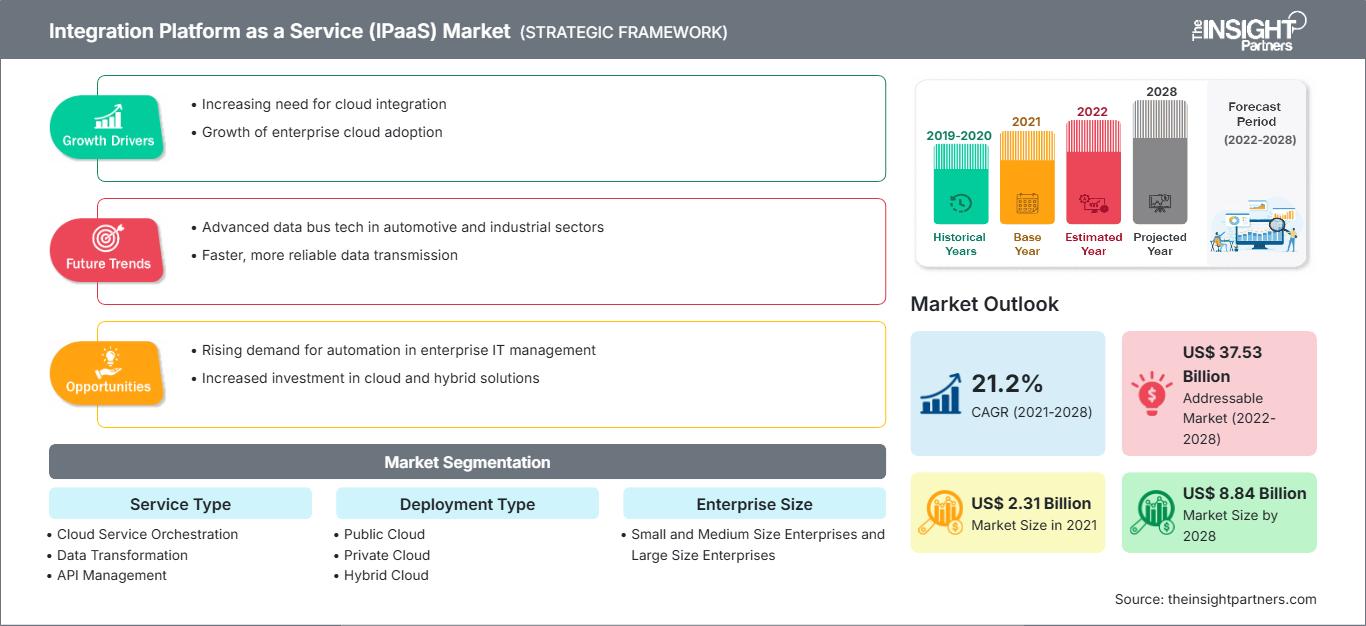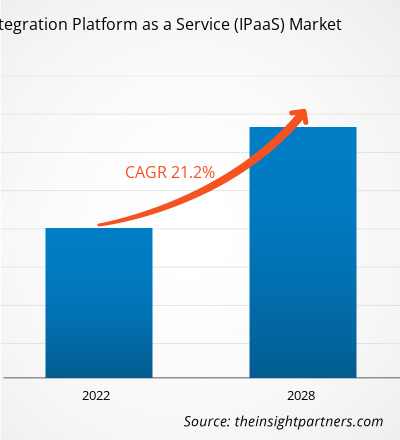Il mercato delle piattaforme di integrazione come servizio (IPaaS) è stato valutato a 2.306,32 milioni di dollari nel 2021 e si prevede che raggiungerà gli 8.844,20 milioni di dollari entro il 2028; si prevede una crescita a un CAGR del 21,2% dal 2021 al 2028.
La crescente importanza del monitoraggio in tempo reale tramite cloud in tutte le aziende sta aumentando la domanda di piattaforme di integrazione come servizio. La sicurezza e le prestazioni della rete possono avere un impatto significativo sul successo complessivo di un'azienda. Pertanto, ogni azienda, soprattutto quelle del settore dell'e-commerce, deve monitorare regolarmente le proprie reti per assicurarsi che tutto funzioni correttamente. È necessario avere una solida comprensione del monitoraggio di rete in tempo reale e dei vantaggi che può apportare alla propria attività, al fine di avere un quadro chiaro dell'efficienza dei sistemi. L'utilizzo di app e strumenti che tracciano e registrano istantanee continue delle prestazioni complessive della rete è noto come monitoraggio in tempo reale. Il monitoraggio in tempo reale viene utilizzato dalle aziende per tenere traccia delle attività di rete, migliorare la sicurezza e individuare eventuali problemi non appena si verificano. Ogni azienda, indipendentemente dalle dimensioni, può trarre vantaggio dal monitoraggio di rete in tempo reale.
Inoltre, i servizi di monitoraggio in tempo reale nel cloud consentono alle aziende di ridurre i tempi di risposta agli incidenti. È fondamentale per le organizzazioni affrontare i problemi non appena si verificano, indipendentemente da quanto possano sembrare di lieve entità. Ad esempio, può sembrare ovvio rispondere rapidamente a un attacco informatico o a una violazione dei dati, ma anche problemi apparentemente insignificanti come un sito web che si carica lentamente o un'eccessiva quantità di pagine web con errore 404 possono avere un impatto significativo sulle aziende. Il monitoraggio di rete in tempo reale può aiutare le aziende a individuare questi eventi non appena si verificano e a reagire rapidamente. Di conseguenza, l'adozione di servizi di monitoraggio in tempo reale nel cloud sta contribuendo alla crescita del mercato nel tempo.
Personalizza questo rapporto in base alle tue esigenze
Potrai personalizzare gratuitamente qualsiasi rapporto, comprese parti di questo rapporto, o analisi a livello di paese, pacchetto dati Excel, oltre a usufruire di grandi offerte e sconti per start-up e università
Mercato della piattaforma di integrazione come servizio (IPaaS): Approfondimenti strategici

-
Ottieni le principali tendenze chiave del mercato di questo rapporto.Questo campione GRATUITO includerà l'analisi dei dati, che vanno dalle tendenze di mercato alle stime e alle previsioni.
L'aumento senza precedenti del numero di casi di COVID-19 in tutto il mondo e il conseguente lockdown per contrastare la diffusione del virus nei primi due trimestri del 2020 hanno costretto numerose aziende a una situazione di stand-by. Nel 2020, gli investimenti tecnologici hanno subito un calo, per i motivi sopra menzionati. Tuttavia, la pandemia di COVID-19 ha accelerato gli scenari di lavoro da casa in tutto il mondo, spingendo così le aziende ad adottare server cloud per il corretto funzionamento delle operazioni aziendali da remoto. Verso la fine del 2020, le aziende globali hanno registrato un aumento degli investimenti in soluzioni cloud per facilitare il lavoro da remoto. Pertanto, si prevede che la crescente adozione di soluzioni e piattaforme cloud in tutte le organizzazioni a livello globale influenzerà l'aumento della domanda nel mercato dei servizi di integrazione di piattaforme, contribuendo così alla crescita del mercato nel periodo di previsione.
Approfondimenti di mercato: crescita del mercato delle piattaforme di integrazione come servizio (IPaaS) nell'adozione di infrastrutture ibride e multi-cloud
Si prevede che, nei prossimi anni, diverse organizzazioni adotteranno strategie ibride e multi-cloud, poiché questi sistemi sono di tendenza nei settori di riferimento. Si prevede che le organizzazioni opteranno per queste strategie poiché sono riluttanti a dipendere da un singolo fornitore cloud. Secondo IBM Corp., il 98% delle organizzazioni prevede di utilizzare più cloud ibridi entro il 2021. Il cloud ibrido offre i vantaggi sia del cloud pubblico che di quello privato, migliorando la flessibilità di utilizzo tra entrambe le soluzioni cloud. Inoltre, consente alle organizzazioni di proteggere i propri dati riservati archiviandoli nel cloud privato e di utilizzare contemporaneamente il cloud pubblico per l'archiviazione dei dati pubblici. I requisiti di applicazioni e funzioni specifiche varieranno con l'aumento dei servizi specializzati. Questo, a sua volta, incoraggia i responsabili aziendali a optare per soluzioni multi-cloud e ibride per gestire il sistema in modo efficace ed efficiente. Inoltre, è conveniente e riduce il rischio di perdite aziendali. L'adozione del cloud ibrido influenzerà anche la crescita del mercato delle piattaforme di integrazione come servizio (IPaaS). Il modello ibrido richiederà un'adeguata integrazione per garantire il corretto funzionamento aziendale nel tempo, contribuendo così alla crescita del mercato.
Approfondimenti basati sul tipo di servizio
In base al tipo di servizio, il mercato delle piattaforme di integrazione come servizio (IPaaS) è segmentato in orchestrazione di servizi cloud, trasformazione dei dati, gestione delle API, integrazione dei dati, monitoraggio e integrazione in tempo reale, integrazione business-to-business e cloud, integrazione del tipo di distribuzione e altri. Il segmento dell'orchestrazione dei servizi cloud ha detenuto la quota di mercato maggiore nel 2020.
Gli operatori che operano nel mercato della piattaforma di integrazione come servizio (IPaaS) si concentrano principalmente sullo sviluppo di prodotti avanzati ed efficienti.
- Nell'aprile 2021, Informatica ha annunciato una piattaforma cloud che impiega microservizi e un motore di intelligenza artificiale per combinare funzionalità di gestione dei dati e consentire l'integrazione di dati e interfacce di programmazione delle applicazioni (API).
- Nell'agosto 2019, MuleSoft, fornitore della piattaforma leader per la creazione di reti applicative, ha annunciato la disponibilità di MuleSoft Government Cloud, un ambiente di distribuzione cloud che combina la piattaforma di integrazione come servizio (IPaaS) e la gestione completa del ciclo di vita delle API in un unico runtime. Distribuendo la piattaforma Anypoint di MuleSoft nell'ambiente Government Cloud, le agenzie possono sviluppare, gestire e monitorare tutte le loro integrazioni e API da una piattaforma unificata, sicura e basata su cloud, semplificando così le operazioni e aumentando l'agilità IT.
Il mercato della piattaforma di integrazione come servizio (IPaaS) è stato segmentato come segue: Mercato della piattaforma di integrazione come servizio (IPaaS) - per tipo di servizio
- Orchestrazione dei servizi cloud
- Integrazione delle applicazioni
- Gestione delle API
- Integrazione dei dati
- Integrazione business-to-business e cloud
- Monitoraggio e integrazione in tempo reale
- Trasformazione dei dati
- Altro
Mercato della piattaforma di integrazione come servizio (IPaaS) - per tipo di distribuzione
- Cloud pubblico
- Cloud privato
- Cloud ibrido
Mercato della piattaforma di integrazione come servizio (IPaaS) - per dimensione aziendale
- PMI
- Grandi imprese
Mercato della piattaforma di integrazione come servizio (IPaaS) - per settore
- IT e telecomunicazioni
- BFSI
- Produzione
- Sanità
- Beni di consumo e vendita al dettaglio
- Energia
- Governo e settore pubblico
- Altri
Approfondimenti regionali sul mercato della piattaforma di integrazione come servizio (IPaaS)
Le tendenze e i fattori regionali che influenzano il mercato dell'Integration Platform as a Service (IPaaS) durante il periodo di previsione sono stati ampiamente spiegati dagli analisti di The Insight Partners. Questa sezione illustra anche i segmenti e la geografia del mercato dell'Integration Platform as a Service (IPaaS) in Nord America, Europa, Asia-Pacifico, Medio Oriente e Africa, America Meridionale e Centrale.
Ambito del rapporto di mercato sulla piattaforma di integrazione come servizio (IPaaS)
| Attributo del rapporto | Dettagli |
|---|---|
| Dimensioni del mercato in 2021 | US$ 2.31 Billion |
| Dimensioni del mercato per 2028 | US$ 8.84 Billion |
| CAGR globale (2021 - 2028) | 21.2% |
| Dati storici | 2019-2020 |
| Periodo di previsione | 2022-2028 |
| Segmenti coperti |
By Tipo di servizio
|
| Regioni e paesi coperti |
Nord America
|
| Leader di mercato e profili aziendali chiave |
|
Densità degli attori del mercato della piattaforma di integrazione come servizio (IPaaS): comprendere il suo impatto sulle dinamiche aziendali
Il mercato delle piattaforme di integrazione come servizio (IPaaS) è in rapida crescita, trainato dalla crescente domanda degli utenti finali dovuta a fattori quali l'evoluzione delle preferenze dei consumatori, i progressi tecnologici e una maggiore consapevolezza dei vantaggi del prodotto. Con l'aumento della domanda, le aziende stanno ampliando la propria offerta, innovando per soddisfare le esigenze dei consumatori e sfruttando le tendenze emergenti, alimentando ulteriormente la crescita del mercato.

- Ottieni il Mercato della piattaforma di integrazione come servizio (IPaaS) Panoramica dei principali attori chiave
-
Nord America
- Stati Uniti
- Canada
- Messico
-
Europa
- Germania
- Francia
- Italia
- Regno Unito
- Spagna
- Svizzera
- Resto d'Europa
-
Asia Pacifico (APAC)
- Australia
- Cina
- India
- Giappone
- Corea del Sud
- Resto dell'APAC
-
Medio Oriente e Africa (MEA)
- Arabia Saudita
- EAU
- Sudafrica
- Resto del MEA
-
Sud America (SAM)
- Brasile
- Argentina
- Resto del SAM
Mercato IPaaS (Integration Platform as a Service) – Profili aziendali
- Informatica
- elastic.io
- Software AG
- Seeburger AG
- Mulesoft, LLC
- SAP SE
- Oracle Corporation
- SnapLogic.
- IBM Corporation
- Microsoft Corporation
- Boomi, Inc
- Analisi storica (2 anni), anno base, previsione (7 anni) con CAGR
- Analisi PEST e SWOT
- Valore/volume delle dimensioni del mercato - Globale, Regionale, Nazionale
- Industria e panorama competitivo
- Set di dati Excel
Report recenti
Testimonianze
Motivo dell'acquisto
- Processo decisionale informato
- Comprensione delle dinamiche di mercato
- Analisi competitiva
- Analisi dei clienti
- Previsioni di mercato
- Mitigazione del rischio
- Pianificazione strategica
- Giustificazione degli investimenti
- Identificazione dei mercati emergenti
- Miglioramento delle strategie di marketing
- Aumento dell'efficienza operativa
- Allineamento alle tendenze normative






















 Ottieni un campione gratuito per - Mercato della piattaforma di integrazione come servizio (IPaaS)
Ottieni un campione gratuito per - Mercato della piattaforma di integrazione come servizio (IPaaS)